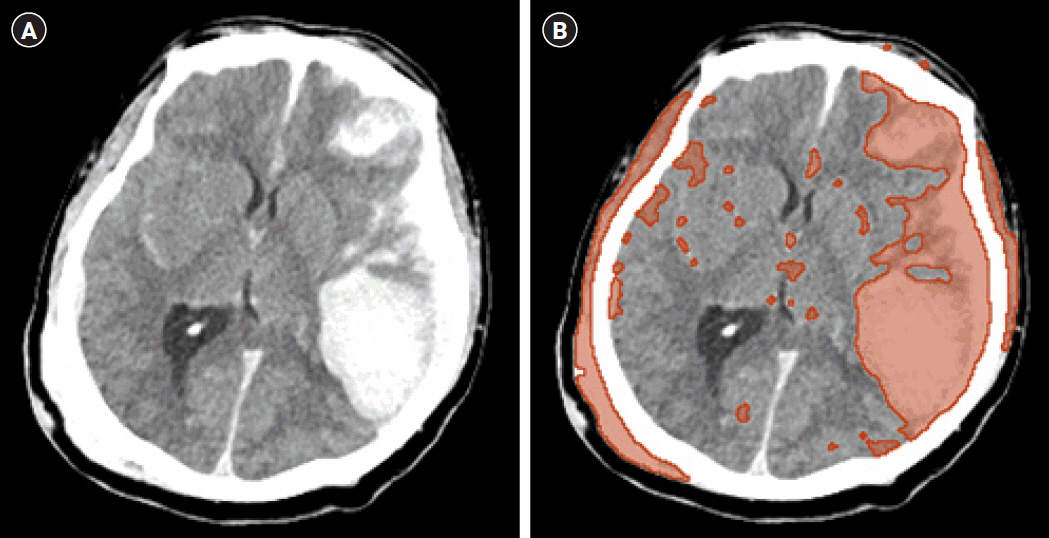Ann Rehabil Med.
2023 Jun;47(3):214-221. 10.5535/arm.23008.
Delirium After Traumatic Brain Injury: Prediction by Location and Size of Brain Lesion
- Affiliations
-
- 1Department of Rehabilitation Medicine, College of Medicine, Ewha Womans University, Seoul, Korea
- KMID: 2543418
- DOI: http://doi.org/10.5535/arm.23008
Abstract
Objective
To examine (1) the location of brain lesion that would predict post-traumatic delirium and (2) the association between volume of brain lesion and occurrence of delirium in patients with traumatic brain injury (TBI).
Methods
A retrospective study was conducted by reviewing medical records of 68 TBI patients, categorized into two groups: the delirious group (n=38) and non-delirious group (n=30). The location and volume of TBI were investigated with the 3D Slicer software.
Results
The TBI region in the delirious group mainly involved the frontal or temporal lobe (p=0.038). All 36 delirious patients had brain injury on the right side (p=0.046). The volume of hemorrhage in the delirious group was larger by about 95 mL compared to the non-delirious group, but this difference was not statistically significant (p=0.382).
Conclusion
Patients with delirium after TBI had significantly different injury site and side, but not lesion size compared to patients without delirium.
Figure
Reference
-
1. Menon DK, Schwab K, Wright DW, Maas AI; Demographics and Clinical Assessment Working Group of the International and Interagency Initiative toward Common Data Elements for Research on Traumatic Brain Injury and Psychological Health. Position statement: definition of traumatic brain injury. Arch Phys Med Rehabil. 2010; 91:1637–40.
Article2. Nakase-Thompson R, Sherer M, Yablon SA, Nick TG, Trzepacz PT. Acute confusion following traumatic brain injury. Brain Inj. 2004; 18:131–42.
Article3. Kluger C, Shah P, Maiti S, Babalola O, Mulvany C, Sinvani L. Therapeutic advances in the prevention and treatment of delirium in the hospital setting. Am J Ther. 2018; 25:e3–14.
Article4. Ganau M, Lavinio A, Prisco L. Delirium and agitation in traumatic brain injury patients: an update on pathological hypotheses and treatment options. Minerva Anestesiol. 2018; 84:632–40.
Article5. Trzepacz PT, Mittal D, Torres R, Kanary K, Norton J, Jimerson N. Validation of the Delirium Rating Scale-revised-98: comparison with the delirium rating scale and the cognitive test for delirium. J Neuropsychiatry Clin Neurosci 2001;13:229-42. Erratum in: J Neuropsychiatry Clin Neurosci. 2001; 13:433.6. Kothari RU, Brott T, Broderick JP, Barsan WG, Sauerbeck LR, Zuccarello M, et al. The ABCs of measuring intracerebral hemorrhage volumes. Stroke. 1996; 27:1304–5.
Article7. Webb AJ, Ullman NL, Morgan TC, Muschelli J, Kornbluth J, Awad IA, et al. Accuracy of the ABC/2 score for intracerebral hemorrhage: systematic review and analysis of MISTIE, CLEAR-IVH, and CLEAR III. Stroke. 2015; 46:2470–6.8. Xu X, Chen X, Zhang J, Zheng Y, Sun G, Yu X, et al. Comparison of the Tada formula with software slicer: precise and low-cost method for volume assessment of intracerebral hematoma. Stroke. 2014; 45:3433–5.
Article9. Chen M, Li Z, Ding J, Lu X, Cheng Y, Lin J. Comparison of common methods for precision volume measurement of hematoma. Comput Math Methods Med. 2020; 2020:6930836.
Article10. Larsen LK, Møller K, Petersen M, Egerod I. Delirium prevalence and prevention in patients with acute brain injury: a prospective before-and-after intervention study. Intensive Crit Care Nurs. 2020; 59:102816.
Article11. Naidech AM, Polnaszek KL, Berman MD, Voss JL. Hematoma locations predicting delirium symptoms after intracerebral hemorrhage. Neurocrit Care. 2016; 24:397–403.
Article12. Boukrina O, Barrett AM. Disruption of the ascending arousal system and cortical attention networks in post-stroke delirium and spatial neglect. Neurosci Biobehav Rev. 2017; 83:1–10.
Article13. Kalvas LB, Monroe TB. Structural brain changes in delirium: an integrative review. Biol Res Nurs. 2019; 21:355–65.
Article14. Qu J, Chen Y, Luo G, Zhong H, Xiao W, Yin H. Delirium in the acute phase of ischemic stroke: incidence, risk factors, and effects on functional outcome. J Stroke Cerebrovasc Dis. 2018; 27:2641–7.
Article15. Pavlovic D, Pekic S, Stojanovic M, Popovic V. Traumatic brain injury: neuropathological, neurocognitive and neurobehavioral sequelae. Pituitary. 2019; 22:270–82.
Article16. van der Naalt J, van Zomeren AH, Sluiter WJ, Minderhoud JM. Acute behavioural disturbances related to imaging studies and outcome in mild-to-moderate head injury. Brain Inj. 2000; 14:781–8.
Article17. Veiga Fernández F, Cruz Jentoft AJ. [Delirium: etiology and pathophysiology]. Rev Esp Geriatr Gerontol 2008;43 Suppl 3:4-12. Spanish. Erratum in: Rev Esp Geriatr Gerontol. 2009; 44:56.18. Oldenbeuving AW, de Kort PL, Jansen BP, Algra A, Kappelle LJ, Roks G. Delirium in the acute phase after stroke: incidence, risk factors, and outcome. Neurology. 2011; 76:993–9.
Article19. Mizuno M. Neuropsychological characteristics of right hemisphere damage: investigation by attention tests, concept formation and change test, and self-evaluation task. Keio J Med. 1991; 40:221–34.
Article20. Naidech AM, Beaumont JL, Rosenberg NF, Maas MB, Kosteva AR, Ault ML, et al. Intracerebral hemorrhage and delirium symptoms. Length of stay, function, and quality of life in a 114-patient cohort. Am J Respir Crit Care Med. 2013; 188:1331–7.
Article21. Reznik ME, Drake J, Margolis SA, Moody S, Murray K, Costa S, et al. Deconstructing poststroke delirium in a prospective cohort of patients with intracerebral hemorrhage. Crit Care Med. 2020; 48:111–8.
Article22. Laurila JV, Laakkonen ML, Tilvis RS, Pitkala KH. Predisposing and precipitating factors for delirium in a frail geriatric population. J Psychosom Res 2008;65:249-54. Erratum in: J Psychosom Res. 2008; 65(5):507.



